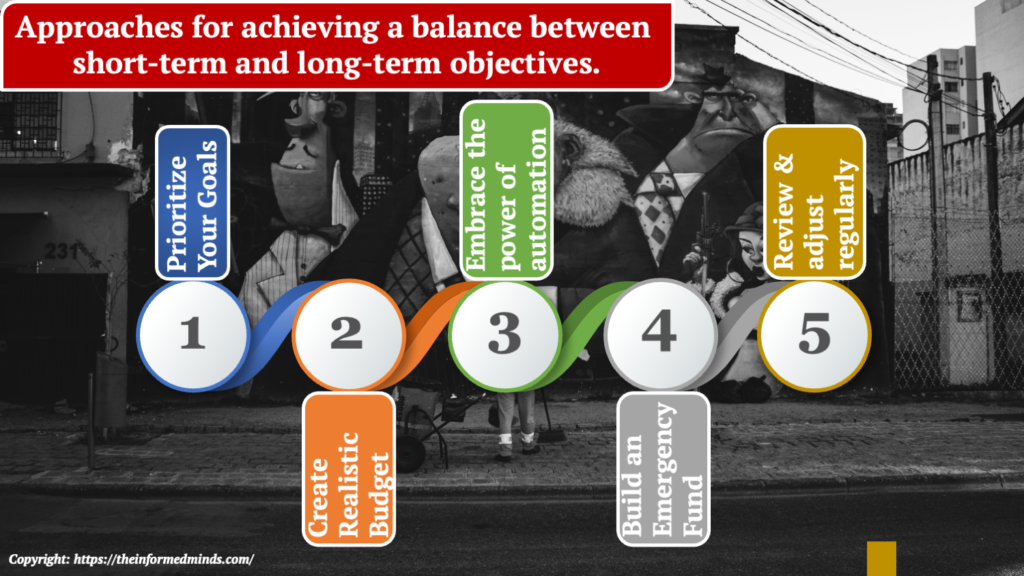To Share is to Show You Care!
In the journey to financial well-being, striking the right balance between short-term desires and long-term goals is the key to achieving lasting success. This comprehensive guide will empower you with the best strategies to master your money, paving the way for a future filled with financial freedom and fulfillment.
Understanding the Challenge
Balancing short-term wants and long-term goals is a universal challenge, but with a strategic approach, you can transform your financial habits. Here’s a breakdown of the best strategies to help you navigate this balancing act.

1. Prioritize Your Goals

Create a List of Goals: Begin by listing your short-term and long-term financial goals. Short-term goals might include paying off credit card debt, while long-term goals could involve saving for a home or retirement.
Priority Setting: Evaluate the importance and urgency of each goal. Some goals may be time-sensitive, while others can be achieved over a more extended period.
Budget Allocation: Allocate specific funds in your budget to each goal. This ensures that you are actively working towards both short-term desires and long-term dreams.
2. Create a Realistic Budget
Track Income and Expenses: Understand your monthly cash flow by tracking both your income and expenses. This gives you a clear picture of where your money is going.
Categorize Spending: Categorize your spending into essentials (like housing, groceries), non-essentials (entertainment, dining out), and savings. This helps identify areas where adjustments can be made.
Balance Immediate Gratification and Savings: A well-balanced budget allows for guilt-free spending on short-term desires while ensuring consistent contributions to long-term savings.

3. Embrace the Power of Automation

Automated Transfers: Set up automated transfers to your savings and investment accounts. This ensures that a portion of your income is regularly directed towards your long-term goals without requiring manual intervention.
Automate Balance: Allocate a specific portion of your income for discretionary spending and automate it. This provides a balance between enjoying immediate pleasures and saving for the future.
4. Build an Emergency Fund
Financial Safety Net: An emergency fund acts as a safety net for unexpected expenses like medical bills or car repairs. It prevents the need to tap into long-term savings during emergencies.
Ideal Size: Aim to save at least three to six months’ worth of living expenses. This provides a cushion in times of financial uncertainty, allowing you to stay on track with your goals.

5. Review and Adjust Regularly

Regular Financial Check-ups: Regularly review your budget and financial goals. This could be done monthly or quarterly.
Adaptability: Be flexible and willing to adjust your plan as circumstances change. Life is dynamic, and your financial plan should evolve with it.
Stay Proactive: Proactively manage your finances. Addressing issues promptly and making necessary adjustments ensures that you stay on course to meet your short-term and long-term objectives.
6. Embracing Financial Freedom
Implementation is Key: The strategies outlined aren’t just theoretical concepts; they are meant to be implemented. Action is the key to financial mastery.
Discipline: Develop discipline in adhering to your financial plan. This discipline is what will propel you towards your financial freedom.
Celebrate Milestones: Celebrate small victories along the way. Acknowledge and reward yourself when you achieve short-term goals, keeping you motivated for the long term.

Conclusion
Dedication and Planning: Achieving a balance between short-term desires and long-term goals requires dedication. Strategic planning is the foundation of successful financial management. Transformative Power: By following these strategies, you’re not just managing your money; you’re transforming your financial future. The journey toward financial freedom is both empowering and fulfilling. Start today, and witness the positive changes in your financial life.
Frequently Asked Questions
Q1: How do you balance short-term and long-term financial goals?
A: To balance short-term and long-term financial goals, start by creating a list of both types of goals. Prioritize them based on importance and urgency. Allocate specific funds in your budget for each goal. Regularly review and adjust your plan, staying disciplined and adaptable to changes in circumstances.
Q2: What are short-term goals and long-term goals in personal finance?
A: Short-term goals in personal finance are objectives that can be achieved in the near future, typically within a year. Examples include building an emergency fund or paying off credit card debt. Long-term goals, on the other hand, extend beyond a year and often involve significant financial milestones like buying a home, saving for retirement, or funding a child’s education.
Q3: How do you balance long-term and short-term goals in your current role?
A: Balancing long-term and short-term goals in my current role involves setting priorities. I prioritize tasks based on their impact on both immediate results and the organization’s long-term objectives. Regularly assessing progress, adjusting strategies, and staying focused on the overarching mission contribute to an effective balance.
Q4: How can you most appropriately balance short-term and long-term results?
A: To appropriately balance short-term and long-term results, it’s crucial to align short-term actions with long-term objectives. Develop a strategic plan that integrates immediate priorities without compromising the overall vision. Regularly evaluate performance, adjust strategies when needed, and maintain a forward-looking perspective.
Q5: What is a short-term and long-term financial decision?
A: A short-term financial decision involves choices that impact the immediate financial situation, such as daily expenses or short-term investments. Long-term financial decisions, on the other hand, affect the financial landscape over an extended period, such as purchasing a home, investing for retirement, or acquiring long-term assets.
Q6: What aims to balance long-term with short-term concerns?
A: Strategic planning aims to balance long-term with short-term concerns. By developing a strategic framework, organizations can address immediate needs while keeping an eye on their long-term vision and goals. This ensures a harmonious integration of short-term actions and long-term sustainability.
Q7: What is a short-term goal example in personal finance?
A: A short-term goal example in personal finance is building an emergency fund. Setting aside a specific amount of money to cover unexpected expenses provides financial security and prevents the need to dip into long-term savings for unforeseen circumstances.
Q8: What are short and long-term goals examples?
A: Short-term goals examples include paying off credit card debt, saving for a vacation, or building an emergency fund. Long-term goals examples encompass buying a home, saving for children’s education, or planning for retirement.
Q9: What is a long-term goal for finance?
A: A long-term goal for finance could involve achieving financial independence or retirement. It may include accumulating substantial savings, investing wisely over time, and creating a sustainable financial plan for the future.
Q10: How do you balance short-term and long-term priorities in managing a global system?
A: Balancing short-term and long-term priorities in managing a global system requires a strategic approach. Prioritize immediate needs without losing sight of the broader, long-term objectives. Adaptability to cultural and market changes, coupled with effective communication, is essential for sustained success.
Q11: Why is it important to have short-term and long-term goals related to financial planning?
A: Having short-term and long-term goals in financial planning provides a roadmap for success. Short-term goals ensure immediate needs are met, while long-term goals contribute to financial security and fulfillment. This dual focus helps individuals make informed decisions, stay motivated, and build a solid financial foundation.
Q12: Why is it important to set short-term and long-term goals?
A: Setting short-term and long-term goals is essential for personal and professional development. Short-term goals provide direction and immediate accomplishments, boosting motivation. Long-term goals create a sense of purpose, guiding individuals towards sustained success and fulfillment over the course of their lives.
The Informed Minds
I'm Vijay Kumar, a consultant with 20+ years of experience specializing in Home, Lifestyle, and Technology. From DIY and Home Improvement to Interior Design and Personal Finance, I've worked with diverse clients, offering tailored solutions to their needs. Through this blog, I share my expertise, providing valuable insights and practical advice for free. Together, let's make our homes better and embrace the latest in lifestyle and technology for a brighter future.

